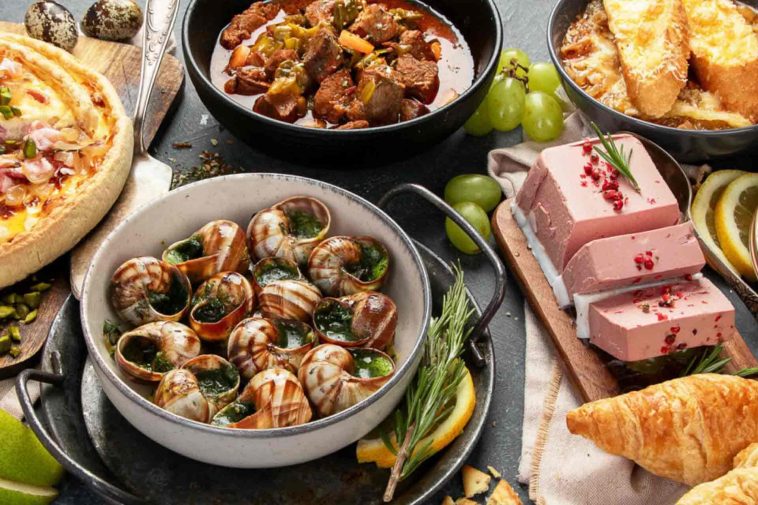French cuisine is renowned for its culinary finesse and gastronomic excellence. Rooted in a rich history, it reflects a deep appreciation for quality ingredients, meticulous preparation, and artistic presentation. This article delves into the essence of French cooking and explores the intriguing inclusion of snails, or escargots, as a celebrated delicacy.
The Essence of French Cuisine
French cuisine, celebrated for its culinary excellence, is deeply rooted in a rich tapestry of traditions. It’s not just about the food; it’s a symphony of history, culture, and art. The essence of French cooking lies in its diversity, with each region contributing its unique flavors and techniques. From the hearty stews of Burgundy to the delicate seafood dishes of Brittany, regional diversity plays a pivotal role in the vast repertoire of French cuisine. This diversity is a testament to the country’s varied landscape and history, making French cuisine a mosaic of gastronomic experiences.
Historical Roots of French Gastronomy
The history of French cuisine is a journey through time, from the opulent feasts of the royal courts to the refined dishes of contemporary kitchens. It evolved through centuries, influenced by political changes, social movements, and cultural exchanges. The Renaissance period introduced sophisticated techniques and exotic ingredients, while the French Revolution democratized fine dining, leading to the emergence of restaurants. This evolution reflects France’s historical trajectory, with each era contributing to the rich tapestry of flavors and techniques that define modern French gastronomy. It’s a cuisine that honors its past while continuously evolving.
To learn more about traditional French cooking techniques, consider exploring French Cooking Classes, which offer insights into the culinary arts that define French gastronomy.
Key Ingredients in French Cooking
The backbone of French cuisine lies in its ingredients – a palette from which chefs create culinary masterpieces. Central to this are butter, cream, and cheese, providing richness and depth. Fresh herbs like thyme and rosemary add aromatic nuances, while garlic and onions form the foundational flavors of many dishes. The significance of fresh, local produce cannot be overstated; it’s the essence of French cooking. Seasonal vegetables, quality meats, and fresh seafood are not just ingredients but the stars of the dish, each playing a crucial role in creating the harmony of flavors that is quintessentially French.
Discover the variety of ingredients and their regional significance in French dishes by visiting Paris Food Tours, where the diversity of French culinary ingredients is beautifully showcased.
French Cooking Techniques
French cuisine is synonymous with culinary finesse, largely due to its array of cooking techniques. Techniques like braising, sautéing, and poaching are staples in French kitchens, each method bringing out different textures and flavors. The art of sauce-making is a hallmark of French cooking, with classics like béchamel and velouté forming the base of many dishes. Baking, too, is an integral part, especially in the world of French pastries and bread. These techniques, refined over centuries, require precision and skill, making the mastery of French cooking both a challenge and a delight for chefs around the world.
Iconic French Dishes
French cuisine boasts an array of iconic dishes, each telling a story of its region. Coq au vin, a Burgundian delight, marries chicken with wine, mushrooms, and bacon. From the southeast comes ratatouille, a vibrant vegetable stew embodying Provence’s bounty. Bouillabaisse, a fish stew from Marseille, showcases the Mediterranean’s seafood. These dishes, among others, highlight regional ingredients and culinary traditions. They are not just meals but reflections of the local culture, history, and geography, making them integral to France’s gastronomic identity. Each dish, with its unique flavors and origins, contributes to the rich mosaic that is French cuisine.
French Desserts and Pastries
Snails in French Cuisine: A Historical Perspective
The tradition of eating snails in France dates back centuries, intertwining with the nation’s culinary history. Initially consumed for sustenance, snails evolved into a symbol of French gastronomy. This transition occurred notably during the Renaissance, aligning with the era’s pursuit of refined and luxurious dining experiences. Snails, particularly the Burgundy snail, became a delicacy, savored by the elite and later embraced by the broader population. Their unique flavor and texture, coupled with sophisticated preparation methods, cemented snails as a quintessential component of French cuisine, reflecting the nation’s penchant for elevating simple ingredients into gourmet fare.
Preparing and Cooking Snails
Preparing snails, or escargots, is an art in French cuisine, involving meticulous steps to ensure their delicate flavor is perfectly captured. Traditionally, snails are purged, boiled, and then removed from their shells. They are then typically cooked in a rich garlic butter, often enhanced with parsley and shallots. This classic recipe, known as Escargots à la Bourguignonne, is a staple in French bistros. Variations include incorporating different herbs, wine, or even stuffing them back into their shells for serving. Each method showcases the versatility of snails and the creativity inherent in French cooking.
Snails as a Delicacy: Cultural and Social Aspects
In French dining culture, snails are more than just a dish; they are a symbol of sophistication and fine dining. Consuming snails is often associated with a refined palate and an appreciation for gourmet experiences. This perception is rooted in their historical association with aristocracy and luxury. In modern times, snails continue to hold a place of esteem in French cuisine, often featured in celebratory meals and esteemed culinary establishments. Their presence on a menu signifies a commitment to traditional, high-quality French cooking, and enjoying them is considered a quintessential French dining experience.
Regional Variations in Snail Dishes
While escargots à la Bourguignonne is the most renowned snail dish, regional variations across France showcase local flavors and traditions. In Provence, snails are often prepared with a medley of herbs de Provence, reflecting the region’s aromatic flora. In Alsace, a Germanic influence can be seen with snails cooked in beer-based sauces. Coastal regions might pair snails with seafood elements, while in Burgundy, the classic garlic and parsley recipe reigns supreme. These regional differences highlight the adaptability of snails as an ingredient and the diversity of French regional cuisines.
Modern Trends and Snail Cuisine
Contemporary French chefs are reimagining snail dishes, infusing them with modern flavors and techniques while respecting their traditional roots. Innovations include incorporating snails into risottos, using them as toppings for gourmet pizzas, or presenting them in deconstructed forms. Snails are also being paired with unconventional ingredients like exotic spices or Asian-inspired sauces, reflecting the global influences in modern French cuisine. This evolution demonstrates the dynamic nature of French gastronomy, constantly evolving while maintaining a deep respect for its heritage.
FAQs: Common Questions About French Cuisine and Snails
- Why do the French eat snails? Snails are valued in French cuisine for their unique texture and flavor, and their preparation is considered an art.
- Are snails a popular dish in France? Yes, snails are a cherished delicacy, especially in fine dining and among culinary enthusiasts.
- How are snails prepared in French cuisine? Traditional preparation involves purging, boiling, and then cooking in garlic butter, often served in their shells.
- What is the historical significance of snails in French cooking? Snails have been part of French culinary tradition for centuries, symbolizing the country’s ability to elevate simple ingredients into exquisite dishes.






Comments
Loading…